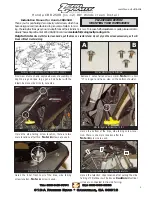
cFP-CB-1/2/3/4
12
ni.com
Thermocouple Wiring
Compact FieldPoint thermocouple input modules can measure the
temperature of the terminals on the cFP-CB-
x
connector block.
The modules use this measurement, called the
cold junction
temperature
, to compensate for the thermoelectric voltages
generated at these junctions. For the most accurate cold-junction
compensation, use the cFP-CB-3 for connecting thermocouple
signals.
Heat dissipated by adjacent modules (or other nearby heat sources)
can cause errors in thermocouple measurements by heating the
terminals to a different temperature than the sensor used to
measure the cold junction. The thermal gradient generated across
the terminals can cause the terminals of different channels to differ
in temperatures. The resulting measurement creates errors in
absolute and relative accuracy between channels. The actual
thermal gradient depends on the connector block you use and
the details of your installation. The following section provides
guidelines for minimizing thermal gradients.
Minimizing Thermal Gradients
To minimize the thermal gradient across the terminals, use the
cFP-CB-3 for connecting thermocouple signals. The cFP-CB-3 is
designed with
isothermal
construction to keep the terminals at the
same temperature. In addition to using the cFP-CB-3, you can
minimize thermal gradients by following these guidelines:
•
Do not place power supplies or other heat sources directly
above or below the Compact FieldPoint system.
•
Do not install high-power modules, such as the cFP-DO-4
xx
and cFP-RLY-4
xx
, adjacent to the cFP-CB-3.
•
Use small-gauge thermocouple wire to transfer less heat.
•
Run thermocouple wires together near the connector block to
keep them at the same temperature.
•
Avoid running thermocouple wires near hot or cold objects.
•
Use the foam cushion strain relief to restrict air flow.






































